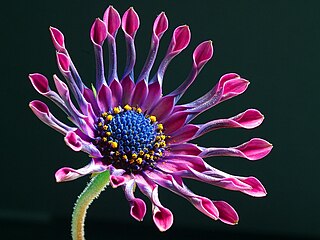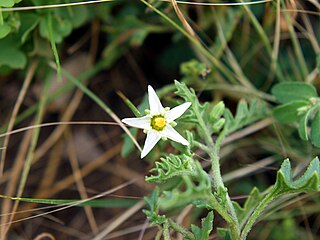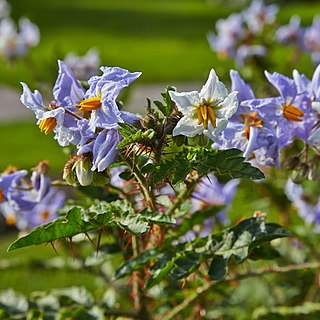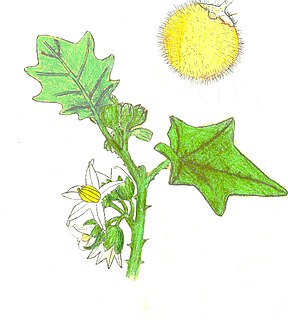
Solanum is a large and diverse genus of flowering plants, which include three food crops of high economic importance: the potato, the tomato and the eggplant. It also contains the nightshades and horse nettles, as well as numerous plants cultivated for their ornamental flowers and fruit.

A cultivar is a type of plant that people have bred for desired traits, which are reproduced in each new generation by a method such as grafting, tissue culture, or carefully controlled seed production. Most cultivars arise from purposeful human manipulation, but some originate from wild plants that have distinctive characteristics. Cultivar names are chosen according to rules of the International Code of Nomenclature for Cultivated Plants (ICNCP), and not all cultivated plants qualify as cultivars. Horticulturists generally believe the word cultivar was coined as a term meaning "cultivated variety".

Solanum dulcamara is a species of vine in the potato genus Solanum, family Solanaceae. Common names include bittersweet, bittersweet nightshade, bitter nightshade, blue bindweed, Amara Dulcis, climbing nightshade, fellenwort, felonwood, poisonberry, poisonflower, scarlet berry, snakeberry, trailing bittersweet, trailing nightshade, violet bloom, and woody nightshade.
Michel Félix Dunal was a French botanist. He was a professor of botany in Montpellier, France.

Solanum pseudocapsicum is a nightshade species with mildly poisonous fruit. It is commonly known as the Jerusalem cherry, Madeira winter cherry, or, ambiguously, "winter cherry". These perennials can be grown decoratively as house plants, but in some areas of South Africa, India, Australia and New Zealand it is regarded as a weed.

Solanum americanum, commonly known as American black nightshade, small-flowered nightshade or glossy nightshade is a herbaceous flowering plant of wide though uncertain native range. The certain native range encompasses the tropics and subtropics of the Americas, Melanesia, New Guinea, and Australia.
A Group is a formal category in the International Code of Nomenclature for Cultivated Plants (ICNCP) used for cultivated plants (cultivars) that share a defined characteristic. It is represented in a botanical name by the symbol Group or Gp. "Group" or "Gp" is always written with a capital G in a botanical name, or epithet. The Group is not italicized in a plant's name. The ICNCP introduced the term and symbol "Group" in 2004, as a replacement for the lengthy and hyphenated "cultivar-group", which had previously been the category's name since 1969. For the old name "cultivar-group", the non-standard abbreviation cv. group or cv. Group is also sometimes encountered. There is a slight difference in meaning, since a cultivar-group was defined to comprise cultivars, whereas a Group may include individual plants.

Solanum mammosum is commonly known as nipplefruit, fox head, cow's udder, or apple of Sodom, is an inedible Pan-American tropical fruit. The plant is grown for ornamental purposes, in part because of the distal end of the fruit's resemblance to a human breast, while the proximal end looks like a cow's udder. It is an annual in the family Solanaceae, and part of the genus Solanum, making the plant a relative of the eggplant, tomato, and potato. This poisonous fruit is native to South America, but has been naturalized in Southern Mexico, Greater Antilles, Central America, and the Caribbean. The plant adapts well to most soils, but thrives in moist, loamy soil.

Solanum nelsonii, common names pōpolo and Nelson's horsenettle, is a partially woody sprawling shrub-like perennial plant in the family Solanaceae, part of the Solanum or nightshade genus. This poisonous plant is endemic to the Pacific Islands. It grows low in coastal sites in coral rubble to pure sand.

Bush tomatoes are the fruit or entire plants of certain nightshade (Solanum) species native to the more arid parts of Australia. While they are quite closely related to tomatoes, they might be even closer relatives of the eggplant, which they resemble in many details. There are 94 natives and 31 introduced species in Australia.

Solanum elaeagnifolium, the silverleaf nightshade or silver-leaved nightshade, is a common native plant to parts of the southwestern USA, and sometimes weed of western North America and also found in South America. Other common names include prairie berry, silverleaf nettle, white horsenettle or silver nightshade. In South Africa it is known as silver-leaf bitter-apple or satansbos. More ambiguous names include "bull-nettle", "horsenettle" and the Spanish "trompillo". The plant is also endemic to the Middle East.

Solanum sarrachoides is a species of South American nightshade known as the hairy nightshade or leafy-fruited nightshade.

The tomato is the edible berry of the plant Solanum lycopersicum, commonly known as a tomato plant. The species originated in western South America and Central America. The Mexican Nahuatl word tomatl gave rise to the Spanish word tomate, from which the English word tomato derived. Its domestication and use as a cultivated food may have originated with the indigenous peoples of Mexico. The Aztecs used tomatoes in their cooking at the time of the Spanish conquest of the Aztec Empire, and after the Spanish encountered the tomato for the first time after their contact with the Aztecs, they brought the plant to Europe, in a widespread transfer of plants known as the Columbian exchange. From there, the tomato was introduced to other parts of the European-colonized world during the 16th century.

Solanum sisymbriifolium is commonly known as vila-vila, sticky nightshade, red buffalo-bur, the fire-and-ice plant, litchi tomato, or Morelle de Balbis.

Solanum rostratum is a species of nightshade that is native to the United States and northern and central Mexico. Common names include buffalobur nightshade, buffalo-bur, spiny nightshade, Colorado bur, Kansas thistle, bad woman, Mexican thistle, and Texas thistle.

Solanum lasiocarpum, synonym Solanum feroxL., otherwise known as Indian nightshade or hairy-fruited eggplant, is a plant that produces edible fruit. Its flowers are white and its fruits are pale yellow.

Solanum diphyllum, commonly known as the twoleaf nightshade, is a species of nightshade native to the Americas. It is cultivated as an ornamental plant for its clusters of dark green round fruits that turn a bright yellow when ripe.

The Solanaceae, or nightshades, are a family of flowering plants that ranges from annual and perennial herbs to vines, lianas, epiphytes, shrubs, and trees, and includes a number of agricultural crops, medicinal plants, spices, weeds, and ornamentals. Many members of the family contain potent alkaloids, and some are highly toxic, but many—including tomatoes, potatoes, eggplant, bell and chili peppers—are used as food. The family belongs to the order Solanales, in the asterid group and class Magnoliopsida (dicotyledons). The Solanaceae consists of about 98 genera and some 2,700 species, with a great diversity of habitats, morphology and ecology.

Solanum heterodoxum, the melonleaf nightshade, is a species of flowering plant in the family Solanaceae. It is native to Mexico and the US state of New Mexico, and has been introduced to Bulgaria. Solanum heterodoxum var. setigeroides is now considered to be a full species, Solanum setigeroides, native to more northerly areas of the United States than S. heterodoxum.

Maria Sergeevna Vorontsova is a Russian-born botanist, specializing in the taxonomy of Poaceae (grasses). She was responsible for authoring the taxon for Solanum agnewiorum and Solanum umtuma. She is a member of the Accelerated Taxonomy department at Royal Botanic Gardens, Kew. She is one of the co-authors and maintainers of GrassBase, and is an editor of the journal, Phytotaxa.

















